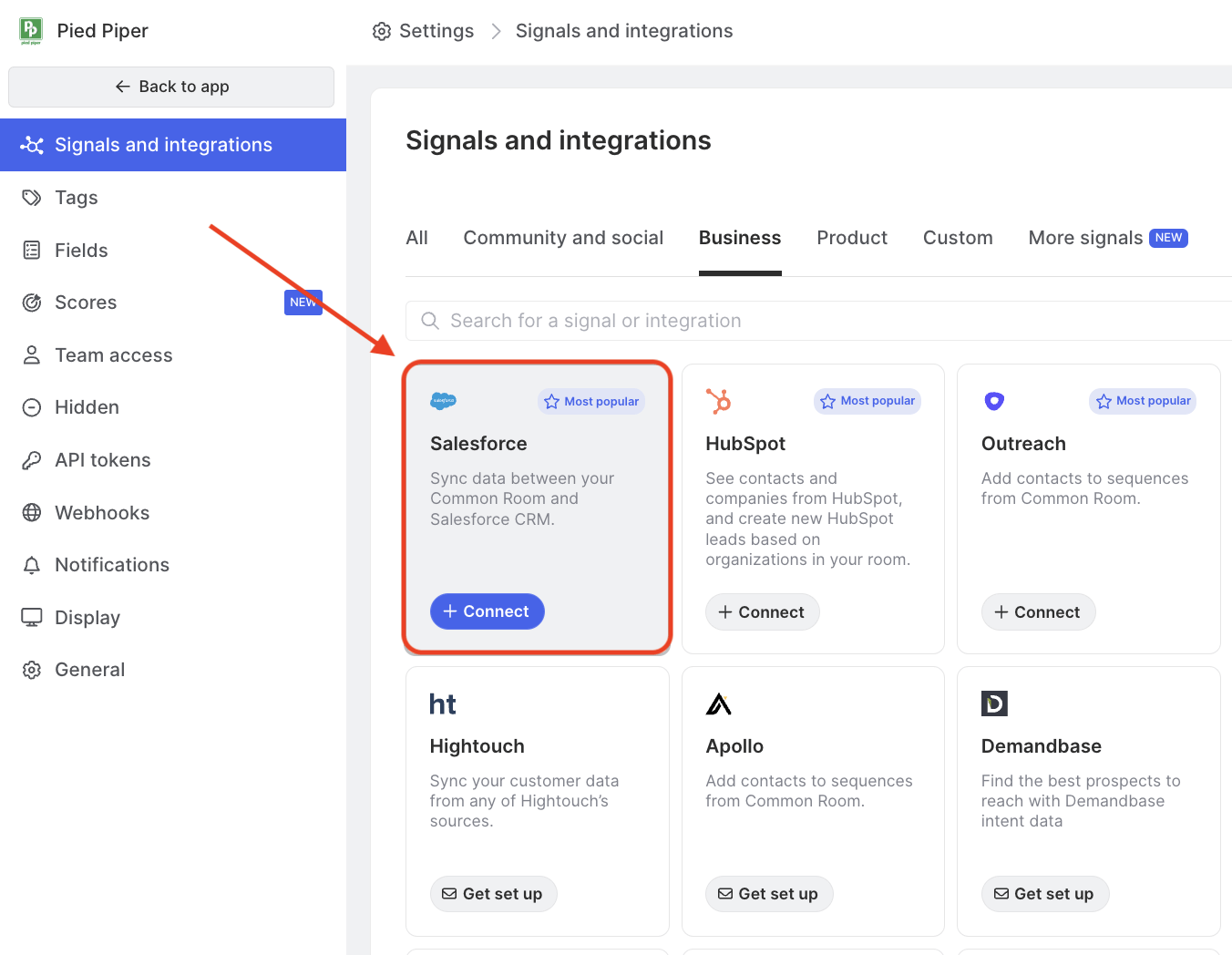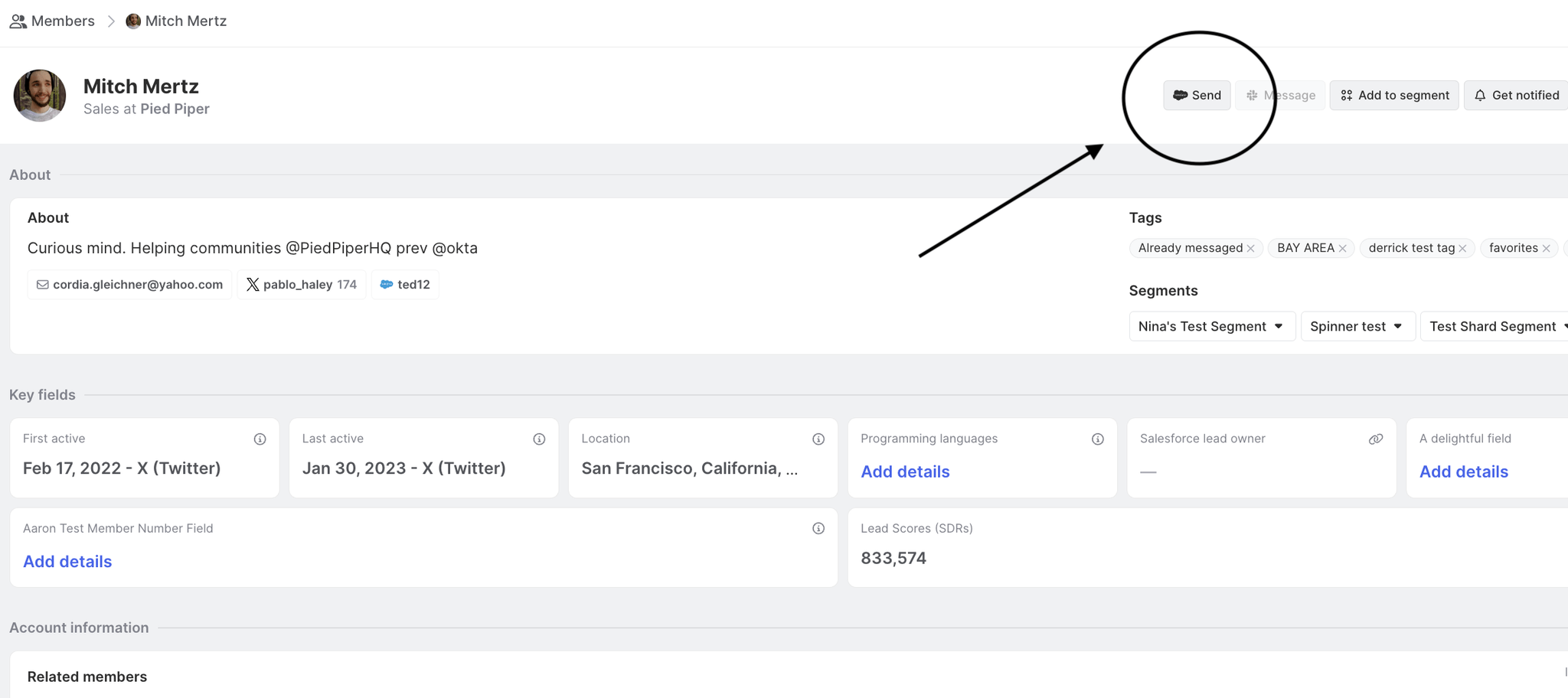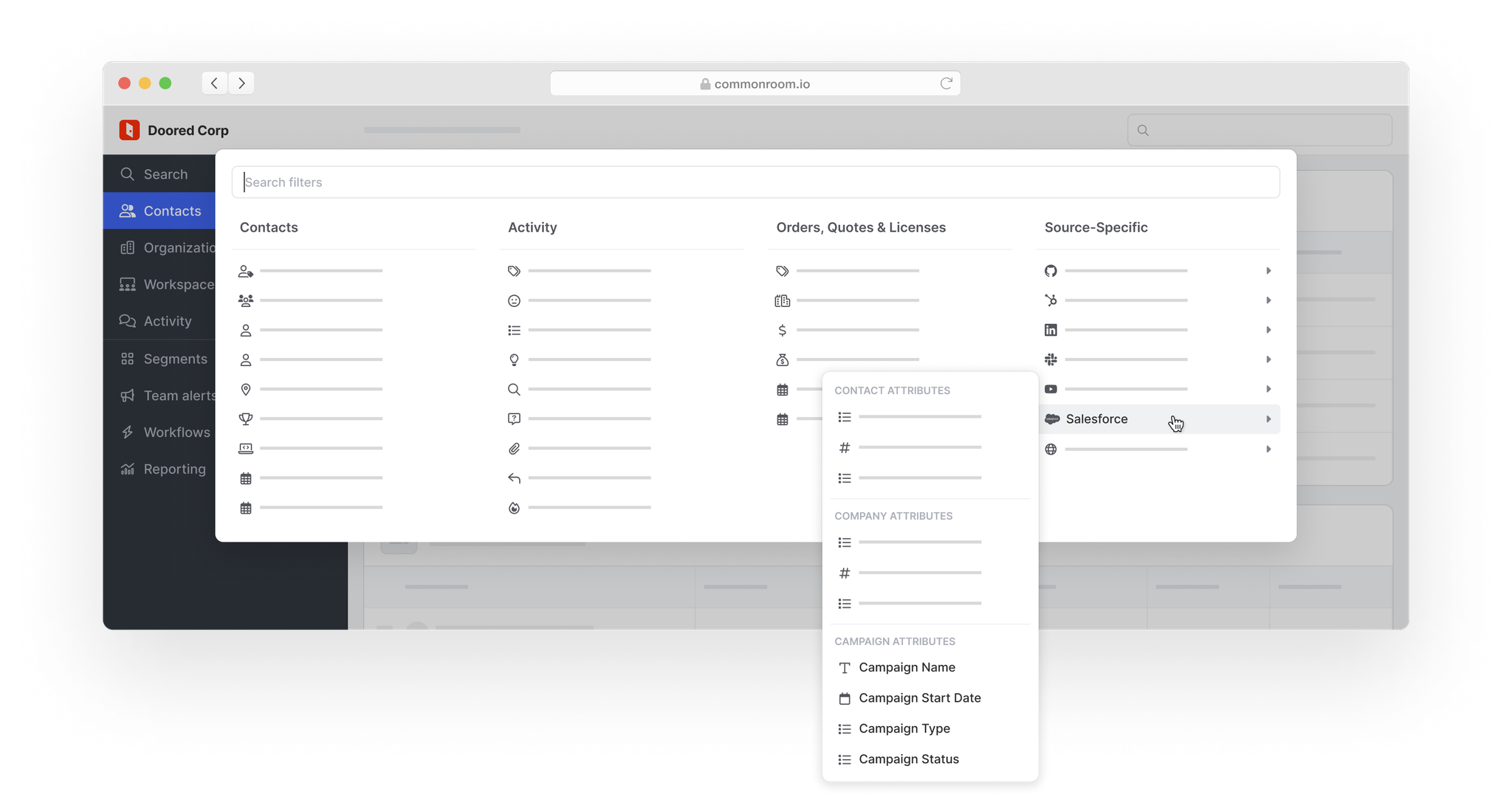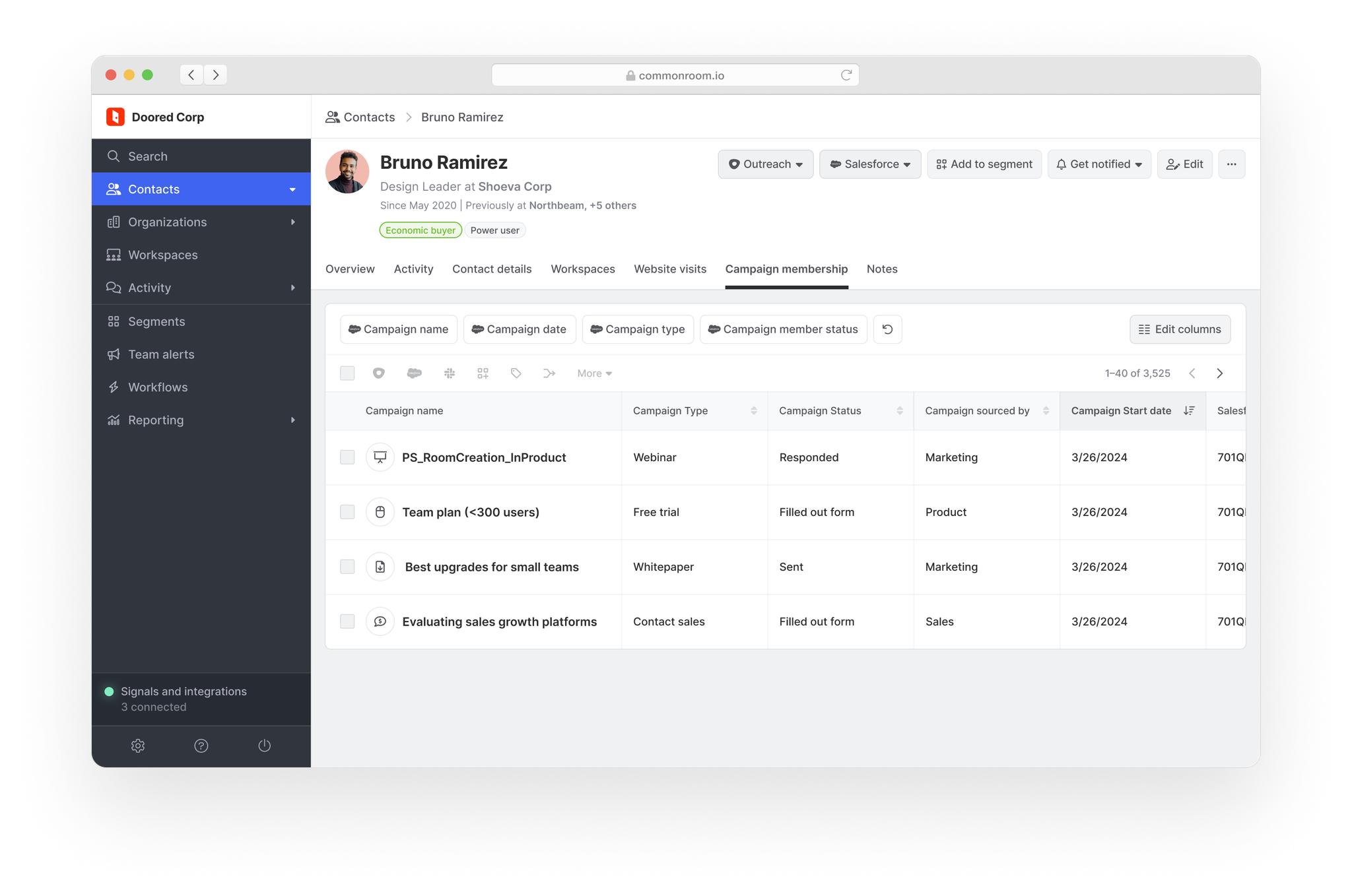 Salesforce CRM Integration Guide
Salesforce CRM Integration Guide
Last updated Apr 18th, 2025
Overview
By connecting Salesforce, you can combine intelligent insights with customer data to expand your pipeline, accelerate deals, and grow your business.
In addition to bringing business context like Lead status and lifecycle stage into your Room, our integration with Salesforce also allows you to sync data from Common Room to your CRM. This means that your sellers can easily see which Leads are already engaged across your signals, their impact, and whether or not they are qualified Leads.

Preparation
You’ll need to have a few things in place to fully configure the Salesforce integration with Common Room.
- Make sure that a Salesforce admin has access to Common Room. If you aren’t an admin, you can invite your Salesforce admin to join your Common Room (see how in the guide below). This will grant them Admin permissions in Common Room and allow them to complete the Salesforce integration.
- Ensure your admin has correct permissions in Salesforce and your organization is on a plan that includes API access. More information on this can be found in this Salesforce guide.
- We recommend creating a separate integration account in Salesforce that isn’t tied to a specific employee for this integration. While not required, this can make it easier for you to manage the integration from Salesforce. This account should be configured with a Salesforce Integration license and will need the following permissions:
- Object Permissions: Read/Write/ViewAll permissions to Lead, Contact,
Account, Opportunity, Campaign - System Permissions: Access Activities
If you need to change the user associated with your Salesforce integration at any point, please email us and our Support team will help you with that change.
- Object Permissions: Read/Write/ViewAll permissions to Lead, Contact,
- Likewise, it may be easier to test this integration using a sandbox environment in Salesforce. In order to connect to a sandbox instance, please authenticate using the following URL (making sure to add your room id):
https://app.commonroom.io/community/<replace-with-community-id>/settings/setup/salesforce?sandbox=true.
If you have any questions about using a sandbox environment, please contact us for help.
Once you have everything above ready, follow the guide below to connect Salesforce to Common Room.
Connect Salesforce to Common Room.
- Open Settings and select Salesforce from the list of sources.
- Confirm that you’re a Salesforce admin. If you aren’t an admin, click the link to invite an admin to your Common Room to continue setting up the integration.
- Authenticate the connection to Salesforce.
Setup Inbound Data from Salesforce to Common Room
In this step, you’ll configure how your Leads, Contacts, Accounts, and Opportunities will map to Contacts and Organizations in Common Room. Additionally, you can configure how Contacts in Common Room are created from your Salesforce Leads and Contacts. You’ll be redirected here after completing the initial connection, but you can always come back to this step by opening Settings → Sources → Salesforce.
Setup Update Settings
- Click Set up under Inbound data setup > Update settings from the Salesforce settings page in Common Room.
- Define which Salesforce fields to map to Common Room. Start by choosing a Salesforce field and then select the associated field in Common Room.
- Continue mapping fields for Contacts, Accounts, and Opportunities.
- Test and validate the sync with Salesforce.
When naming the Common Room field to map to, we recommend that you prefix the name to distinguish that it is coming from Salesforce.
We also support importing Salesforce campaign membership for your contacts. More specifically, you can import campaign and campaign membership level fields for contacts in Common Room that have a matching contact in Salesforce. Once the campaign sync is set up, these fields will be synced for all contacts in Common Room that are matched to a Salesforce contact. The default fields available to sync into Common Room include:
- Campaign Id
- Campaign Name
- Campaign Type
- Campaign Status
- Campaign Start Date
- Campaign Member Status
Please contact us if you would like to set this up.
We recommend importing business context from your Leads, Contacts, Account, and Opportunities that can be useful to know about a Common Room contact. We've filled in some recommended fields to help you get started, but you can add more fields as needed. Note that we also require a few fields in order to provide the best product experience.
Setup creates settings
Once you have defined your inbound update settings, it's important to understand that by default, only Common Room contacts that have a matching lead or contact (by email) in Salesforce will be updated with the Salesforce data. If you would like to create net new contacts in Common Room from your Salesforce leads and contacts, use the Create settings to set this up.
Important: You will be setting up a filter criteria based on Salesforce fields. These fields must be mapped in the previous Update step in order to be available in the filter.
Important: If you do not specify any filter criteria and save your create settings, ALL of your Salesforce leads and/or contacts will be created in Common Room. If you have more than 200k contacts, please contact us before proceeding.
- Click Set up under Inbound data setup > Create settings from the Salesforce settings page in Common Room.
- Enable the desired toggle for Create contacts from Salesforce leads and/or Create contacts from Salesforce contacts.
- Specify the creation filters based on the Salesforce fields.
- Confirm that the estimated number of contacts is the expected value with your Salesforce admin.
- Press Save changes to proceed with creating contacts in Common Room
Setup Outbound data from Common Room to Salesforce
Once you’ve setup the inbound data from Salesforce to Common Room, follow along below to configure how Common Room will update existing Leads, Contacts and Accounts in Salesforce. Additionally, you can configure Common Room will create new Leads or Contacts in Salesforce.
Setup Update Settings
- Navigate to the Outbound data setup section of the Salesforce settings page in Common Room.
- Click Set up to get started.
- Define which fields to map to Salesforce. We’ll recommend some fields to start, but you can map any Common Room field to Salesforce, or even create a new static field if needed.
A static field syncs a set value from Common Room to Salesforce. This can be useful for identifying values that don’t change—for example, if you choose to create Lead fields, you can use a static field to set the Lead source as Common Room.
Validate Data Updates
Once you’ve finished setting up your field mappings and are ready to test, find a Contact you know exists in your Salesforce instance and open their Contact profile. Press the Send to Salesforce button to sync the mapped fields for this Contact to Salesforce, then view that Contact in Salesforce to confirm that all fields are updated as expected.
There is currently no way to sync an individual organization to a Salesforce account. We recommend that you validate organizations using a test field before proceeding to enabling the auto-update. Contact us with any questions.

Enable Auto Updates
If everything looks good and you’re ready to set up your daily outbound sync, return back to the Outbound update settings page.
Enabling auto-update for leads and contacts will update all leads and contacts in Salesforce that have a matching primary email.
Enabling auto-update for accounts will update all accounts in Salesforce that have a matching root domain (e.g. http://www.commonroom.io and http://www.commonroom.io/home would both be considered a match).
Setup creates settings
- Navigate to the Outbound data setup section of the Salesforce settings page in Common Room.
- Click Edit creation setup.
- Set Creation settings to control what happens when a Contact is discovered in Common Room that doesn’t yet exist in your Salesforce. You can choose either to create Leads or create Contacts.
- Map fields to Salesforce. Similar to the update steps above, Common Room will recommend some fields, but you can add any Common Room field or create your own static fields.
- Define criteria for when a new Lead or Contact should be created. You can use all of the filter options available elsewhere in Common Room. (For example, if you only wanted contacts with the titles Software Engineer, Software Developer, and Staff Software Engineer to be created as contacts in Common Room, you could set select the "job title" filter and select these options). Make sure to preview how many Contacts will be created by setting up the corresponding filter in the Contact explorer.
- Validate data creation to make sure the associated Leads/Contacts that will be created appear as you'd expect. To do this, once you’ve finished setting up your field mappings and are ready to test, open the Contacts page and find a Contact that doesn’t yet exist in Salesforce. Note that this Contact will need to have a primary email in order to be synced to Salesforce. Press the Send to Salesforce button to sync this Contact to Salesforce and confirm that the corresponding Lead or Contact is created as expected.If everything looks good and you’re interested in automatically creating Leads or Contacts in your Salesforce, return back to the Outbound create settings page to configure your auto-create settings.
- Enable auto updates under "Sync Settings" if everything looks good and you’re ready to set up your automatic sync.
Manually Creating a Lead/Contact in Salesforce
After you review a contact tagged as a qualified Lead in Common Room, you can manually push the contact to Salesforce via the "Send to Salesforce" button on the Contact profile, Contact explorer, and Contact lists in segments to create a new Lead or Contact (depending on how you've set up your Salesforce integration) for your sales and marketing teams to review. When you create a new Contact in Salesforce via Common Room, Common Room populates the First Name, Last Name, and Email Salesforce Contact fields by default.
Technical Details
Requirements
The Salesforce CRM integration with Common Room is included in our Enterprise plan and available as an add-on for Starter and Team plans.
Inbound Sync Details (Salesforce to Common Room)
Contacts and organizations
When the integration is first configured, Common Room will sync field data for all Salesforce Leads, Contacts, Accounts and Opportunities that have a corresponding match in your room. Salesforce Leads and Contacts are associated based on the Common Room Contact's email address. Salesforce Accounts and Opportunities are associated with Common Room by using an Organization’s domain and name.
This integration matches fields from Salesforce for existing Contacts in Common Room, the Salesforce integration does not create new Contacts in Common Room by default. Please contact us if you would like to enable this feature.
Campaign and campaign membership
Importing campaign and campaign membership details into Common Room enables you to filter by any of these campaign level field when setting up your segments, creating scores, or simply exploring your contacts. You simply need to let us know which campaign and campaign membership level fields you would like to import into Common Room and we will help configure this for your room. Please contact us if you would like to get this set up in your room.
Once your room is set up, the campaign and campaign membership level fields will be available on Common Room contacts that have a matching contact in Salesforce. You can find the campaign filters available under the Source Specific filters.

The campaign membership details will also be available on a contact profile's page.

Import history
When the integration is first configured, Common Room will sync the configured fields for all matching Salesforce Leads, Contacts, Accounts, and Opportunities in your room.
Ongoing sync
Once the integration is set up, Common Room can be configured to import new fields from Salesforce every 15 minutes to daily depending on your needs. Common Room will sync data back to Salesforce on a daily basis.
Outbound Sync Details (Common Room to Salesforce)
Contact field sync to Salesforce
For any Contacts already synced between Salesforce and Common Room, Common Room can automatically update their Salesforce contact fields to include relevant context.
We generally recommend creating new Salesforce fields for any context being sent back to Salesforce from Common Room to prevent overriding of existing data.
To track which contacts are created by Common Room in your Salesforce instance, we recommend adding a static field to your “Outbound Create” mapping. We would generally recommend naming it “Lead Source” (for leads) or “Contact Source” (for contacts) and setting it to the static value Common Room.
The following fields are available to sync into Salesforce for contacts:
- City
- Common Room Contact Link
- Community Engaged
- Community Qualified (CQ)
- Community Qualified Date
- Company Name
- Company Website
- Country
- Discord Usernames
- Emails
- Employment Role
- Employment Title
- First Activity Date
- First Activity Signal
- First Name
- First Seen Date
- First Seen Signal
- Full Name
- Github Usernames
- Impact Points 12 Weeks
- Last Activity Date
- Last Activity Signal
- Last Company
- Last Company Change Date
- Last Company Title
- Last Name
- Last Seen Date
- Last Seen Signal
- Last Segment Actioned On By
- Last Segment Actioned On URL
- Last Segment Actioned On Date
- Last Segment Actioned On Name
- Last Segment Actioned On Action
- LinkedIn Usernames
- Phone Number (appears twice in original)
- Primary Email
- Region
- Segment names
- Signals
- Slack Linked
- Slack Usernames
- Twitter Handles
Additionally, we support mapping any contact level custom field from Common Room to Salesforce. This can be useful for syncing over data such as contact scores over to Salesforce.
Company field sync to Salesforce
For any organizations synced between Salesforce and Common Room, Common Room can automatically update their Salesforce account fields to include relevant context.
We generally recommend creating new Salesforce fields for any context being sent back to Salesforce from Common Room to prevent overriding of existing data.
The following fields are available to sync into Salesforce for organizations:
- Capital Raised
- Common Room Org Link
- Community Engaged
- Description
- Employee Count
- First Activity Date
- First Activity Signa
- First Seen Date
- First Seen Signal
- Impact Points 12 Weeks
- Impact Points All Time
- Last Activity Date
- Last Activity Signal
- Last Seen Date
- Last Seen Signal
- Number of Active Members 12 Weeks
- Number of Active Members All Time
- Number of Members
- Resolved Location City
- Resolved Location Country
- Resolved Location Country Region
- Revenue Range Max
- Revenue Range Min
- Sub Industry
- Technologies
Additionally, we support mapping any organization level custom field from Common Room to Salesforce. This can be useful for syncing over data such as organization scores and calculated fields over to Salesforce.
Sending contacts from Common Room to a Salesforce campaign
You can send a Common Room contact to a Salesforce campaign in one of three ways:
- Pressing the "Send to Salesforce campaign" button from a Contact's profile
- Selecting multiple Contacts from the Contact explorer and pressing the "Send to Salesforce campaign" action button
- By creating a workflow from scratch and adding the "Send to Salesforce campaign" action as the last step of the workflow
Depending on how your Salesforce outbound settings are configured, the resulting behavior in Salesforce will differ as follows:
- If you don't have any outbound settings configured, we will do a best-effort assignment of the associated Lead/Contact to the campaign without any additional updates. No Leads/Contacts will be created in Salesforce.
- If there is only an update setting configured, we will also update fields for matched Leads/Contacts but will never create.
- If there is only a create setting configured, we will only create new Contacts but not update fields for any of the matched Leads/Contacts.
- If both update and create settings are configured, sending to a campaign will assign to a campaign, update matched Leads/Contacts and also create new Leads/Contacts if we don't have a match.
FAQs
How does Common Room associate pipeline/ARR to a person?
Annual recurring revenue (ARR) is mapped to a Contact based on the corresponding Organization they’re associated with.
Can I surface qualified Leads and Lead/Contact creation in Salesforce from Common Room?
It's common to have Contacts who are potential Leads and ready to engage with a Contact of your sales team, but who aren't yet created as a Lead or Contact in your Salesforce. Common Room can help you automatically identify qualified Leads based on criteria specific to your business (e.g. Industry = Financial Services AND Annual revenue > $1M AND > 2 Slack posts in the last month AND mentioned “pricing”). You may work with the Common Room team to define your automated qualification criteria.
Is it possible to sync Activity outbound from Common Room to Salesforce?
No, it's only possible to sync Activity inbound from Salesforce to Common Room.
Is it possible to integrate both Salesforce and HubSpot with Common Room?
If you use Salesforce as your CRM and HubSpot as your MAP (Marketing Automation Platform), you may want to integrate both with Common Room to get a holistic view of your Contacts and Organizations. This is possible today, but it’s important to keep a few important things in mind.
- Syncing data into Common Room: The main consideration when syncing data in from both Salesforce and HubSpot is that it may be difficult to differentiate which custom field is mapped to which tool. A simple recommendation here is to prefix custom field names based on the tool, for example, SF Lead Status and HS Lead Status
- Syncing data out to Salesforce / HubSpot: When syncing data out of Common Room, the most important consideration is any existing sync between Salesforce and HubSpot. Most customers we’ve worked with either have a bi-directional sync with a subset of qualified Leads from Salesforce to HubSpot or sync all Leads between Salesforce and HubSpot. If you’re interested in syncing data out from Common Room in either of these scenarios, we recommend that you pick one tool to target in order to avoid any conflicts during the sync.
What fields do you recommend we map from Common Room to Salesforce?
Here are some commonly mapped fields for contacts:
- Profile Url -> "Common Room Profile URL"
- Company name -> "Common Room Company Name"
- Title -> "Common Room Job Title"
- Employment Role -> "Common Room Job Role"
- Professional email -> "Common Room Work Email"
- All emails -> "Common Room Email(s)"
- Signals -> "Common Room Signals"
- First Activity Date -> "Common Room First Activity Date"
- First Activity Signal -> "Common Room First Activity Signal"
- City -> "Common Room City"
- Region -> "Common Room State/Region"
- Country -> "Common Room Country"
Here are some commonly mapped fields for accounts:
- Industry -> "Common Room Industry"
- Employee Count -> "Common Room Employee Count"
- # Revenue Range Min -> "Common Room Min Revenue"
# Revenue Range Max -> "Common Room Max Revenue"
How can I map Lead and Account scores in Common Room to Salesforce?
Lead and account scores are stored as custom fields so they can be mapped out to SFDC. To set this up, please reach out to your CSM for further assistance.
The Salesforce integration user will be API only - will this cause any issues when authorizing the connection?
API only is fine as long as the integration user has permissions to view/edit leads, contacts, accounts, opportunities and campaigns.
Can we use a Salesforce Integration license, or does the integration user need a full Salesforce license?
A Salesforce Integration license should be fine.
How are Common Room organizations matched to Salesforce accounts?
An organization in Common Room is a representation of a real-world company that uses both AI models and human intervention to provide an up-to-date view of the company. This means that in Common Room, entities that represent subsidiaries or variations of an organization will ladder up to a single parent organization. This is all done using a company's domain.
When Salesforce is connected, we match all of the known domains associated with an organization against the website of the Salesforce accounts to build the one-to-many view of accounts you see on an organization's profile.
The following logic is used to normalize account websites for matching purposes:
- Remove hashes, fragments, trailing slashes and query parameters
- Strip any leading www (while preserving any non-www subdomain)
- Preserve any paths (e.g. www.mycompany.com/mypath will preserve the "/mypath" portion)
- If a Salesforce account has a Website field of "www.mycompany.com/mypath", it will not be matched to "www.mycompany.com" until the Website is updated to be "www.mycompany.com" in Salesforce.
- This helps prevent accounts with Websites that use shared domains (e.g. "www.bit.ly/company-name") from being matched to the incorrect organization (e.g. "bit.ly").
When syncing organization data from Common Room to Salesforce accounts, all matching accounts that have the same top level domain as the organization will be updated.